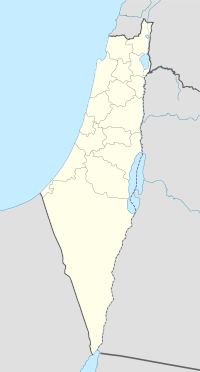Al-Ghubayya-al-Fawqa
| Al-Ghubayya al-Fawqa | |
|---|---|
| Arabic | الغبية الفوقا |
| Also spelled | Ghubayya al Fauqa |
| Subdistrict | Haifa |
| Coordinates | 32°36′5″N 35°9′5″E / 32.60139°N 35.15139°ECoordinates: 32°36′5″N 35°9′5″E / 32.60139°N 35.15139°E |
| Palestine grid | 164/223 |
| Population | 1130 (1945) |
| Date of depopulation | April 8–9, 1948 |
| Cause(s) of depopulation | Military assault by Yishuv forces |
Al-Ghubayya al-Fawqa was a Palestinian Arab village in the Haifa Subdistrict. It was depopulated during the 1947–48 Civil War in Mandatory Palestine on April 8, 1948 during the Battle of Mishmar HaEmek. It was located 28 km southeast of Haifa.
During the early Ottoman era, in 1596 the village appeared under the name of Gubayya in the tax registers, being part of the nahiya (subdistrict) of Sahil Atlit in the Sanjak (district) of Lajjun. It had a population of 39 households; an estimated 215 people, all Muslim. They paid a fixed tax-rate of 25% on agricultural products, including wheat, barley, summer crops, goats and beehives, and water buffaloes; the taxes totalled 21,690 akçe.
Al-Ghubayya al-Fawqa shared an elementary school built by the Ottomans in 1888 with the nearby villages of al-Ghubayya-al-Tahta and al-Naghnaghiyya. The school was later closed during the British Mandate period. The village had its own mosque.
In the 1922 census of Palestine, conducted by the British Mandate authorities, Ghabba al-Fuqa had a population of 41 Muslims. In the 1931 census, the two al-Ghubayya village were counted together, and the total population was 200 Muslims, in 38 houses.
In 1945 the population was counted with the neighbouring al-Ghubayya-al-Tahta and al-Naghnaghiyya, and together they had a population of 1,130 Muslims, with a total of 12,139 dunams of land according to an official land and population survey. Of this, 209 dunams were for plantations and irrigable land, 10,883 for cereals, while a total of 1,047 dunams were non-cultivable land.
...
Wikipedia

